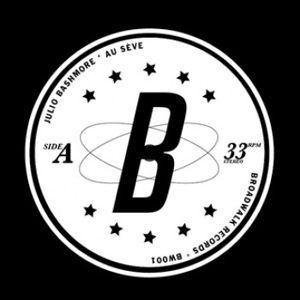Julio Bashmore Au Seve EP
“Au Seve” marks the latest milestone in the rise of low-end-loving house producer Julio Bashmore. […]

“Au Seve” marks the latest milestone in the rise of low-end-loving house producer Julio Bashmore. In case you’ve somehow missed the hype, the past few years have seen Bashmore emerge as the one of the bright young hopes of British dance music, emerging out of Bristol’s club scene (with some support from Claude VonStroke and his Dirtybird imprint) to claim a place at the forefront of a mini house renaissance. Over the past 18 months, Bashmore has kicked that rise into overdrive, owning 2011 with omnipresent floor filler “Battle For Middle You,” scooping a slot on BBC Radio 1’s late-night schedule, and scoring DJ gigs of ever-increasing prominence. Now, he’s launched his own label, Broadwalk, and “Au Seve” has arrived as the inaugural release.
It’s a fitting debut for the imprint, the a-side acting almost like a calling card, bearing all the hallmarks—both positive and, to a lesser extent, negative—of Bashmore’s production style. “Au Seve” is undoubtedly an excellently crafted house tune; as with all of Bashmore’s best work, the production is near-faultless, and the whole thing is perfectly structured and fine tuned to draw the maximum amount of drama out of the infectious bass and synth hook. Even more impressive, it manages to do so without ever feeling hammy or overdone. It’s an immaculate exercise in retro house music, but that’s also its biggest flaw. As enjoyable as “Au Seve” is, it’s hard to shake the feeling that the track is effectively a retro piece. Literally every sound—from the drum samples to the toplines—could have been lifted from disco and Chicago-house records, and the hook is based around a generic vocal sample. The same can be said for “Troglodytes,” which shares the 12″‘s a-side. It’s another exceptionally well-made piece of bouncy, disco-tinged house, but one that’s equally backward looking and also focused around a knowingly tacky spoken-word vocal.
The b-side is different story altogether, and a relatively confusing one at that. Consisting of 20 minutes of apparently unnamed music, it seems to include somewhere between one and four different tracks. It’s a rambling exercise in chopped-and-screwed disco that owes a debt to Oneohtrix Point Never and the 100% Silk stable; it’s late-night house slowed down to around half speed, warped like a dated 8-track tape as it fades in and out of washes of reverb. It’s strange, relatively inaccessible, and probably about 14 minutes longer than it needs to be, but—particularly after the straight-laced tribute paying of the a-side—it’s great.
Without question, both “Au Seve” and “Troglodytes” are enjoyable, infectious, and brilliantly executed house tunes. Furthermore, it would be unfair to act like Bashmore is the only producer out there reanimating classic house styles. (He’s certainly not the worst offender either.) But if the juxtaposition of the more leftfield flipside on this 12″ makes anything clear, it’s that a producer of Bashmore’s talents has more to offer than just homage-paying dancefloor ammunition. Let’s hope we see more of that experimental side in the future.

